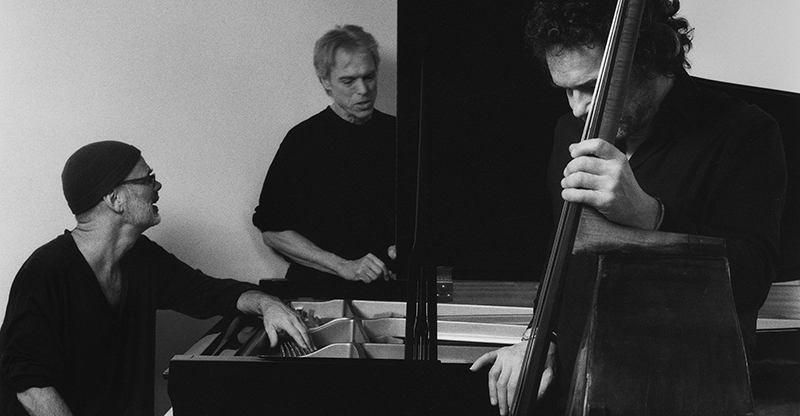
the WHO trio
Strell Project || WHO Zoo || About || Previous Recordings - Reviews + Audio || YouTube || BandCamp || Photos || Biographies



[*****} Anyone who was there can be happy and feel confirmed: With its Ellington project "Strell", the WHO Trio provided a great Willisau concert in 2023. Last but not least, the performance conveys a refreshing and clever way of dealing with the jazz tradition, combining it with one's own musical development and remaining authentic at the same time. Michel Wintsch, Bänz Oester and Gerry Hemingway deal with compositions by Duke Ellington and Billy Strayhorn, which they do not simply interpret, but actually absorb.
The trio calls its approach "Reimaginations", which hits the core of their approach: instead of interpreting the pieces so-called freely or deconstructing them in an artificial way, they bring the material, the riffs and the motifs into the present with their own emotions and their joy of playing. "The feeling of swing is our own, but shaped by the pieces we play," says Hemingway in Andy Hamilton's liner notes. The three musicians, who are experiencing a great moment here as an alert, interacting collective, know the material and treat it like a syllable structure of their own language extended into the past. Some pieces begin with the Reimagination and then lead into the Ellington theme, in other pieces the Ellington piece comes first and only then the Reimagination, which is precisely indicated on the CD cover.
In addition to well-known numbers such as "Mood Indigo" or "Black and Tan Fantasy", the trio also plays rarely heard pieces such as "Birmingham Breakdown" or "Self Portrait of the Bean". The music is always in flow, melodic and abstract, swinging and complicated, varied and at times extravagant. On "Fleurette Africaine", Ellington's voice fades in, on "Black and Tan Fantasy", Hemingway's vocalizations give the old-time jazz classic a touching urgency.
Jazz'n'More - Pirmin Bossart
[*****} The old saying that a prophet is not honored in his own country certainly does not apply to the Who Trio. In Switzerland, the trio, consisting of Geneva pianist Michel Wintsch, Bern bassist Bänz Oester and American drummer Gerry Hemingway, is one of the best-known groups in the field of jazz and improvised music. It has existed in the same line-up for more than two decades. The trio's latest stroke of genius is the concert recording here. Well-known and rarer Duke Ellington compositions were performed in an unusual format. The program consists of seven numbered pieces called "Reimagination" as well as an "Interlude" and "Wig Wise", also by Ellington. In pieces like "Mood Indigo" or "The Mooche", perfectly formed architectures are formed from myriads of complex rhythmic segments, basic bass figures, attractive motif sequences and free phantasms by the pianist. A process that is reminiscent of a rush through musical dream sequences. What more could you want? One of the most vitalizing releases of the year!
FonoForum, December 2024 - Gerd Filtgen
This jewel of an album was released just too late for inclusion in AAJ's Best Jazz Albums of 2024: All-Star Break Edition, where contributors were invited to name their three best albums released during the first half of the year. But five gets you ten that it will be included in at least one end-of-year best-albums list. And that is not the only headline. Live At Jazz Festival Willisau 2023 is that rarer than hen's teeth thing: an album that could appeal equally to aficionados of free-leaning collective improvisation, in this case by a piano trio, and also to connoisseurs of early to mid 20th century changes-based jazz standards, in this case compositions by Duke Ellington.
The WHO Trio—pianist Michael Wintsch, bassist Banz Oester and drummer Gerry Hemingway—have been here before. Their previous album, Strell (Clean Feed, 2021), recorded in 2019, had the musicians roaming through and beyond nine Ellington and Billy Strayhorn pieces. Four years later at Willisau the trio took the concept to the next level: seven of the nine tracks are either preceded or followed by "Reimagination" sections. These collective improvisations are abstracted so far from the Ellington source material, of which only distant echoes remain audible, that their composer credits are, with justice, attributed to Wintsch, Oester and Hemingway.
Some of the pieces on the album are well known: "Mood Indigo," "The Mooche" and "Black And Tan Fantasy." Others are relatively obscure: "Birmingham Breakdown" and "Self Portrait Of The Bean." Another three sit in between: "Wig Wise," "Angelica" and "Fleurette Africaine." The ninth track, "Interlude," halfway through the performance, is a brief WHO improvisation.
There are many moments of transcendent beauty on Live At Jazz Festival Willisau 2023, too many to itemize here. And by no means all of them are Ellington's original themes. Wintsch, Oester and Hemingway are such supremely lyrical players that they create passages of exquisite melodicism even on the hoof and out there. Oester, who introduces the themes as often as Wintsch, brings a deliciously "dirty" quality to his pizzicato playing, frequently plucking the strings in such a manner that they vibrate percussively against the fingerboard. Hemingway uses the cymbals sparingly, mainly focusing on tuned toms and bass drum, so bringing an out-of-the-ordinary tunefulness to his drumming. An exception is "Wig Wise / Reimagination #5," where snare drum and cymbals are to the fore. Wintsch commands attention by turning on a dime between high intensity Cecil Taylor-like two-hands passages and pelucid single-note lines.
Chris May, July 24, 2024 in AllAboutJazz
Anyone who was there can be happy and feel confirmed: With its Ellington project "Strell", the WHO Trio provided a great Willisau concert in 2023. Last but not least, the performance conveys a refreshing and clever way of dealing with the jazz tradition, combining it with one's own musical development and remaining authentic at the same time. Michel Wintsch, Bänz Oester and Gerry Hemingway deal with compositions by Duke Ellington and Billy Strayhorn, which they do not simply interpret, but actually absorb.
The trio calls its approach "Reimaginations", which hits the core of their approach: instead of interpreting the pieces so-called freely or deconstructing them in an artificial way, they bring the material, the riffs and the motifs into the present with their own emotions and their joy of playing. "The feeling of swing is our own, but shaped by the pieces we play," says Hemingway in Andy Hamilton's liner notes. The three musicians, who are experiencing a great moment here as an alert, interacting collective, know the material and treat it like a syllable structure of their own language extended into the past. Some pieces begin with the Reimagination and then lead into the Ellington theme, in other pieces the Ellington piece comes first and only then the Reimagination, which is precisely indicated on the CD cover.
In addition to well-known numbers such as "Mood Indigo" or "Black and Tan Fantasy", the trio also plays rarely heard pieces such as "Birmingham Breakdown" or "Self Portrait of the Bean". The music is always in flow, melodic and abstract, swinging and complicated, varied and at times extravagant. On "Fleurette Africaine", Ellington's voice fades in, on "Black and Tan Fantasy", Hemingway's vocalizations give the old-time jazz classic a touching urgency.
Vincenzo Roggero in AllAboutJazz
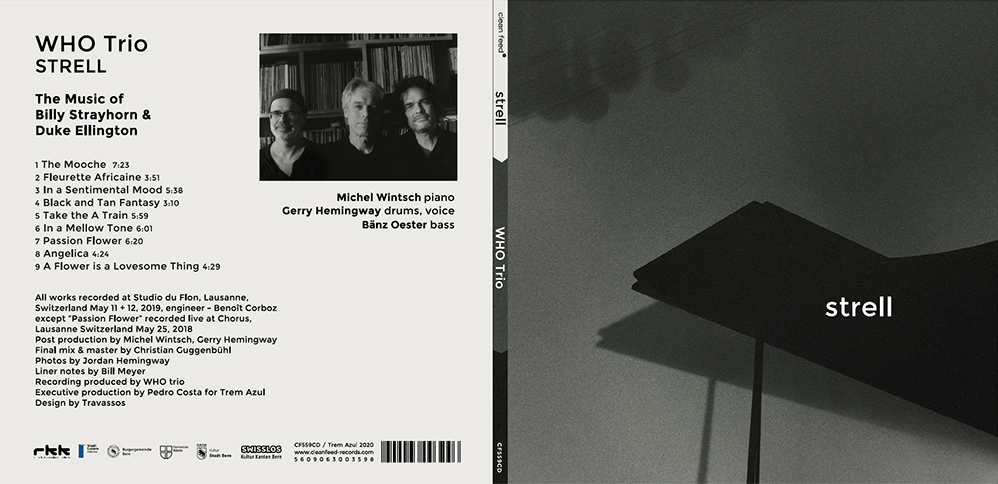
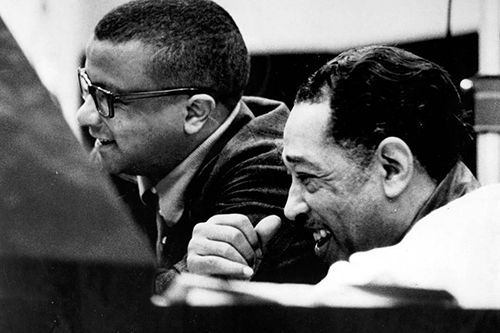
“STRELL” is the newest project of the WHO trio; a unique interpretation of the music of Billy Strayhorn & Duke Ellington.
In 2018 it was twenty years that the WHO trio had toured internationally, exploring a music between composition and improvisation, continually developing a singular language common to it’s three members.
Now this collective language has reached a level of maturity where it seems possible to touch something that the trio holds dear and which has an important place in a shared musical culture: the music of Billy Strayhorn and Duke Ellington.
The WHO trio’s goal is to infuse this rich musical heritage with today’s musical words, and to do so with the love of this music that guides and inspires new musical creations.
These timeless compositions are a crucible of inspiration. They are like a mighty wave, allowing the trio to surf to new horizons. A source nurturing the trio, without constraining it’s possibilities.
WHO Trio perform Strell at AMR Cropettes - July 1, 2021 - Whole Concert from the "STRELL" cd of the WHO trio
A Flower is a Lovesome Thing from the "STRELL" cd of the WHO trio
It is a new reading, with it’s feet in tradition, combining the centrality of the blues at the heart of this repertoire with the open spirit of improvisation which offer new departures created from the subtle and unpredictable interactions of the WHO trio.
[****} While their approach here to the compositions of Ellington and Strayhorn significantly loosens the rhythmic and harmonic structures of the material, leaving it free to drift into new shapes and patterns, WHO possesses some essential qualities with which to address this work, a certain wit and also an innate elegance, a certain grace that’s part of the respect that much of the material--too subtle to demand—requires (some of the older material seems to need a certain rough touch). FreeJazzBlog - Stuart Broomer
No one has bested Duke Ellington’s mastery of all things musical and no group of musicians in recent memory has done greater justice to the Ellington / Strayhorn’s songbook as a pan-genre blueprint than WHO Trio. InOnTheCorner - kmcoultas
Le trio de choc WHO comme Wintsch, Hemingway et Oester adapte ici à sa manière les musiques de Duke Ellington et Billy Strayhorn. Démontage en règle de Take the A train et autres Passion Flower. Caractérisé par l’engagement physique impressionnant des trois complices de longue date, un traitement au chalumeau de l’improvisation parmi les plus audacieuses, auquel rien ne résiste. À eux trois, ils jettent cent mille volts d’éclairage nouveau sur des musiques quasi impérissables.
[translation exc] Characterized by the impressive physical commitment of the three long-time accomplices, a torch treatment of the most daring improvisation, which nothing can resist. Between them, they throw a hundred thousand volts of new light on an almost imperishable music.
Viva la musica - par Jacques Mühlethaler
Si on peut se régaler des interprétations originales, et pourquoi pas d’une certaine tendresse pour ces années révolues, le WHO trio nous gratifie de versions radicalement neuves, belles, épurées des accents d’alors, comme s’il s’agissait de compositions d’aujourd’hui. C’est un bain de jouvence de ces trésors passés. Une joie irrésistiblement contagieuse.
[translation from french] If we can feast on original interpretations, and why not a certain tenderness for these bygone years, the WHO trio gives us radically new versions, beautiful, refined with the accents of the time, as if they were compositions today. It is a rejuvenation of these past treasures. An irresistibly contagious joy.
Guy Sitruk - Jazz à Paris - Canal Blog (2021)
Four Stars **** Nouveaute. Apres plus de vingt ans de complicité, Wintsch, Hemingway et Oester (WHO) proposent un sixième album en accord avec le renouvellement des matériaux et des prétextes qu'ils s'imposent, depuis la chanson française ("Open Songs") jusqu'a l'improvisation libre électrique ou acoustique ("Zoo"). Le livret décrit bien comment, aux prises avec les univers insécables de Billy Strayhorn et Duke Ellington, ils en ant extrait la substance brute pour la transporter dans des regions insoupçonnées sans jamais s'en défaire tout a fait. Superposant habilement les sources thématiques et taus les prolongements qu'elles leur inspirent, ils nous parlent des ambiguïtés, des contrastes et des dilemmes qui traversent et nourrissent les melodies et les climats sonores ellingtoniens, de la délicatesse la plus policée aux pulsions indomptées. On se regale de (Fleurette Africaine), scandée sauvagement par la contrebasse au coeur d'une toile compacte, de l'humour désopilant d'un (Take The A Train) ou une machinerie percussive se met lentement en route pour couvrir définitivement le theme, ressasse par une main gauche indifférente et mecaniqué. In A Sentimental Mood est une exploration mélodique et sonore en totale apesanteur rythmique. Ça bricole des sourdines avec un abat-jour pose sur la caisse (The Mooche), ça chante tout en retenue et en délicatesse (A Flower Is A Lovesome Thing), c'est très sérieux mais souvent très drôle.
Vincent Cotro - Jazz Magazine
[Translation friom French} Four Stars **** New. After more than twenty years of complicity, Wintsch, Hemingway and Oester (WHO) offer a sixth album in accordance with the renewal of the materials and the pretexts they impose on themselves, from French chanson ("Open Songs") to free electric or acoustic improvisation ("Zoo"). The booklet describes well how, grappling with the indissoluble universes of Billy Strayhorn and Duke Ellington, they extracted the raw substance to transport it to unsuspected regions without ever completely getting rid of it. Skillfully superimposing the thematic sources and all the extensions they inspire, they speak to us of the ambiguities, contrasts and dilemmas that run through and nourish the melodies and sound climates of Ellington, from the most polished delicacy to untamed impulses. We regale ourselves with "Fleurette Africaine" wildly punctuated by the double bass in the heart of a compact canvas, the hilarious humor of a "Take The A Train" where a percussive machinery slowly sets out to cover the theme definitively, rehashes by an indifferent and mechanical left hand. "In A Sentimental Mood" is a melodic and sonic exploration in total rhythmic weightlessness. It tinkers with mutes of a lampshade sung through on a snare drum, "The Mooche", it sings with restraint and delicacy "A Flower Is A Lovesome Thing", it's very serious but often very funny.
Vincent Cotro - Jazz Magazine
Jazz'n'More 5 stars * * * * * - Bei STRELL geht es um die "Musik von Billy Strayhorn und Duke Ellington", eine neue anspruchsvolle. Aufgabe, der sich das Trio von Wintsch, Hemingway und Oester alias WHO zum sechsten Album nach uber 20 Jahre nach seiner Grundung stellt. Es gibt mindestens zwei Annaherungsmoglichkeiten an dieses rundum gelungene Album. Die erste besteht darin, als Ellington-Strayhorn-Fan - oder einfach jazzhistorisch interessierte Persondiese neun neuen lnterpretationen zu geniessen. Das macht sichtlich Spass, in jeder Hinsicht. Beginnen wir mit "Take the a Train", einem der bekanntesten Stucke aus der Feder von Strayhorn, nach 1940 ein wahrer Hit in Amerika, das hier in ein fast schon ekstatisch anmutendes Finale mundet. Neben Standards wie "In a Sentimental Mood" oder "In a Mellow Tone" greift WHO auch auf weniger bekannte Songs aus den Sechzigerjahren wie "Passion Flower" oder "Angelica" zuruck. Die zweite Annaherung an dieses Album blendet die historische Dimension aus und verfolgt die spannenden lnteraktionen von drei grossen Individualisten, die einander zu fordern verstehen. Beide Zugangsformen an dieses Album bieten die Moglichkeit, die offenen Strukturen der Ellington-Strayhorn-Vorgaben sowie das enorme interaktive Potenzial des Trios - nacheinander oder gleichzeitig - zu geniessen.
Ruedi Ankli - Jazz'n'More Nov/Dec 2020
[translation] Jazz'n'More 5 stars * * * * * STRELL is about the "music of Billy Strayhorn and Duke Ellington", a new and demanding one. The task that the trio of Wintsch, Hemingway and Oester alias WHO set for their sixth album after more than 20 years after its foundation. There are at least two approaches to this all-round successful album. The first is to enjoy these nine new interpretations as an Ellington Strayhorn fan - or simply a person interested in jazz history. It's obviously fun in every way. Let's start with "Take the a Train", one of the most famous pieces from the pen of Strayhorn, a real hit in America after 1940, which leads to an almost ecstatic finale here. In addition to standards such as "In a Sentimental Mood" or "In a Mellow Tone", WHO also falls back on lesser-known songs from the 1960s such as "Passion Flower" or "Angelica". The second approach to this album fades out the historical dimension and follows the exciting interactions of three great individualists who know how to challenge each other. Both forms of access to this album offer the opportunity to enjoy the open structures of the Ellington-Strayhorn specifications as well as the enormous interactive potential of the trio - one after the other or at the same time.
Ruedi Ankli - Jazz'n'More Nov/Dec 2020
[Excerpt - translation below] In questo album, inciso quasi per intero in studio a Losanna nel maggio 2019 (fa eccezione "Passion Flower," ripresa dal vivo un anno prima nella stessa città), il lavoro di scavo e ricostruzione (o riappropriazione, se preferite) appare senz'altro convincente, originale, in particolare nei due brani d'avvio, dove il portato tematico risulta felicemente allitterato, quasi scomposto con tecnica che potremmo definire cubista, spezzettato, a volte quasi evaporato (ma qui possiamo farci entrare, a intervalli, l'intero trattamento dei brani), altrove come scomposto e riposizionato fra le curve dello sviluppo espositivo (anche qui in senso lato).
Via via che il disco precede (di fatto fin dal terzo brano in scaletta, "Fleurette Africaine") l'inflessione—e quindi la leggibilità—diventa più esplicita, diretta, con risultati particolarmente felici soprattutto nel citato "Passion Flower," decisamente vitale, e in "Angelica," uno dei temi più originali, fortemente caratterizzati, del songbook in oggetto. Alberto Bazzurro, All About Jazz, February 23, 2021
[Exc Translated from Italian] In this album, recorded almost entirely in the studio in Lausanne in May 2019 (with the exception of "Passion Flower," recorded live a year earlier in the same city), the work of excavation and reconstruction (or re-appropriation, if you prefer) appears unquestionably. Completely convincing, original, in particular in the two opening passages, where the thematic result is happily alliterated, almost broken down with a technique that we could define cubist, fragmented, sometimes almost evaporated (but even here they let us enter, at intervals, the entire treatment of the pieces), elsewhere as broken down and repositioned between the curves of the exhibition development (also here in a broad sense).
As the disc precedes (in fact since the third track in the set, "Fleurette Africaine") the inflection - and therefore the readability - becomes more explicit, direct, with particularly joyful results especially in the aforementioned "Passion Flower," which is decidedly vital, and in "Angelica," one of the most original and strongly characterized themes of the songbook they present. Alberto Bazzurro, All About Jazz, February 23, 2021
It is enough to listen to STRELL: The Music of Billy Strayhorn & Duke Ellington two or three times (we are sure that in the first one little or nothing is understood) to raise the white flag and surrender completely to nine completely absorbing, intelligent and passionate compositions.
The result is a very personal sound, which moves away from some of the conventions that many of us assume are typical of current jazz, to instead offer that type of music that asks and wonders, building enigmatic landscapes in which great details are found. subtlety and that we begin to capture when we listen to the album "once again".
Strell is the kind of record that asks you to turn off your mobile, make yourself comfortable, press "Play" and do nothing else.
Rudy de Juana , 2020 TomaJazz
"Originell zum Original"
.....WHO Trio. Allesamt nicht nur hervorragende, feinsinnige Instrumentalisten, sondern über den Jazz und die Improvisation hinaus mit kompositorischem Format reich gesegnet, holen sie mit «Strell» nach fünf Alben und zumeist eigenen Songs nun Strayhorn und Ellington aufs eigenwilligste und zugleich schönste in ihre Gegenwart. Vorausgegangen sein muss eine intensive Beschäftigung damit. Denn ob «In a Sentimental Mood», wo jede einzelne (Bass-)Note zum Grossereignis wird, in «The Mooche», in dem Hemingway durch einen Aluminium-Lampenschirm blechern in die Snare singt, oder wenn in «Take The ‹A› Train» eine monotone Mundharmonika ein betörendes Ostinato begleitet, das überraschend in rasanteste Pianoläufe übergeht: stets dient das Originelle ganz dem neuen Original, den Strayhorn-Ellington-Themen, die sich das Trio so zärtlich wie unverblümt zu eigen macht.
Steff Rohrbach 14.07.2021 Weltwoche
(translated from German ...) WHO Trio. All of them not only excellent, sensitive instrumentalists, but also richly blessed with compositional format beyond jazz and improvisation, with "Strell" they now bring Strayhorn and Ellington into their presence in the most idiosyncratic and beautiful way after five albums and mostly their own songs. This must have been preceded by an intensive study of it. Because whether it's “In a Sentimental Mood”, where every single (bass) note becomes a major event, in “The Mooche”, in which Hemingway sings tinny into the snare through an aluminum lampshade, or when in “Take The ‹A› Train »a monotonous harmonica accompanies a beguiling ostinato, which surprisingly turns into the fastest piano runs: the original always serves the new original, the Strayhorn-Ellington themes, which the trio affectionately and bluntly adopt.
Steff Rohrbach 14.07.2021 Weltwoche
WHO trio have a refreshing take on the piano trio format and on "Strell" they apply this with enthusiasm and ingenuity to the music of Billy Strayhorn and Duke Ellington. It takes a delicate balance to combine a free jazz approach with interpreting the material and creating drama - and they succeed. The tracks unfold with plenty of suspense to repay the listener's attention.
Far from a conventional trio sound, WHO often sound as mysterious and multi-colored as the Ellington band. Drummer Gerry Hemingway makes striking vocal contributions - usually wordless and with acoustic effects such as singing through an aluminum lampshade into his snare drum, recalling the muted brass effects of 1920s Ellington.
The instruments are recorded close up and vividly - because they're all panned across the stereo spectrum it can be hard to detect which instrument creates which sound, even with headphones. Pianist Michel Wintsch uses extended techniques like plucking or muting strings so all three musicians play both a melodic and a percussive role. The music is mostly contrapuntal, with little in the way of "jazz soloing" - this is made possible by a high degree of understanding between players who've worked together over 20 years.
At times I was reminded of both the Spontaneous Music Ensemble and Keith Jarrett. The material chosen ranges from well-trodden (Take the A Train, In a Mellow Tone) to less familiar tunes like "Angelica" and "A Flower is a Lovesome Thing". The combination of great compositions and creative playing, laced with both humor and intensity produce a rewarding album.
Stephen Godsall/Jazz Halo
Le trio « Who » – Qui ?, Un trio qui fête ses 20 ans – bouscule les règles bien établies de cette formation. La batterie prend la direction, le piano se met à la place de la batterie et la basse peut se faire batterie ou piano, les thèmes circulent pour prendre un aspect bizarre à nos oreilles. L’inquiétante familiarité s’immisce dans le cerveau enfiévré qui cherche des points de repères, en trouve, les perd, les cherche pour se lancer à l’assaut d’autres manières d’entendre, pour casser nos routines.
Tenter l’aventure. Vous ne connaissez pas Duke Ellington, cet album, « Strell », peut servir d’intro, par le mélange même de la chronologie. En écoutant Duke et Billy, vous apprécierez le travail du trio et entrerez dans les arcanes du jazz pour ne plus en sortir. Si vous avez entendu et aimé la musique de ces deux créateurs, vous serez transportés en découvrant, grâce à ce trio, qu’ils ont encore beaucoup de choses à nous dire…
Nicolas Béniès, Le Souffle Bleu
[Translation from French] The WHO trio celebrating its 20th anniversary - is shaking up the well-established rules of this formation. The drums take the lead, the piano takes the place of the drums and the bass can be drums or piano, the themes circulate to take a bizarre aspect to our ears. Disturbing familiarity creeps into the feverish brain, which searches for landmarks, finds them, loses them, seeks them in order to launch an assault on other ways of hearing, to break our routines.
Try the adventure. If you don’t know Duke Ellington, this album, "Strell", can serve as an intro, even mixing up the timeline. While listening to Duke and Billy, you will appreciate the work of the trio and will enter into the arcana of jazz to never leave it. If you have heard and liked the music of these two creators, you will be transported to discover, thanks to this trio, that they still have a lot to tell us ...
Nicolas Béniès, Le Souffle Bleu
Review in Salt Peanuts : Jan Granlie
The Recording Session of "STRELL"
Performance excerpts "STRELL"
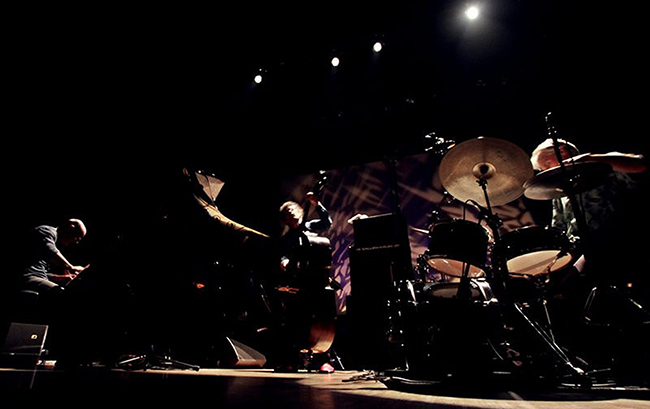
The trio of Michel Wintsch (Geneva, Switzerland), Bänz Oester (Bern, Switzerland) and Gerry Hemingway (from NYC now living in Luzern Switzerland) began touring and recording together in 1998. Earlier, Wintsch and Hemingway first worked together in 1995 when they recorded together with cellist Martin Schütz for Unit Records. Chris Parker of BBC music writes "...the compositions are wholly absorbing, rousingly unpredictable, cleverly structured pieces that elicit performances of extraordinary subtlety and delicacy yet scrupulously controlled power" and Andy Hamilton of Jazz Review observes that "The result is always intriguing and often compelling, displaying a clear compositional intelligence...".
As the trio has developed it's sound and conception, a compelling evolution has developed from the diverse compositional and improvisational sensibilities of all three members. What has grown from those sensibilities is an openness, a willingness to listen and dig deeply into the uncharted terrain of open improvisation. The WHO trio are now clearly three musicians whose refined listening yields an uncommon musical sensitivity, an unspoken agreement that the collective creation is priority over individual contributions, and an honesty and immediacy that engage every audience in every context.
In the course of their touring together as a trio and occassionally with larger ensemble settings, they have developed what in music is often enigmatic, a sound as a group. This sound has many characteristics, among them, a transparency that allows the more delicate and subtle details to be perceivable to every listener. They have also achieved a more elastic sensibility with rhythm that lends a fluency, tension and excitement to their powerful rhythmic interaction. Each time they have convened for another project or tour a new quality has developed in the trio's expressive repertoire. In one instance Michel introduced a number of classic French "chansons" into the program and with this developed a deeper elemental resonance to their music as a whole. On another occasion, some of which is documented on "Sharing the Thirst", the trio deepened it's feeling for powerful grooves of every conceivable kind.
It is not unusual to hear this conventional jazz instrumentation rock like Massive Attack, cook like Fela, swing like Count Basie, and bump & grind like Buddy Guy. All three players are very physical with their instruments and although the recordings are a good indication of what to expect, there is much more to look forward to when experiencing this trio in concert. Words though belie the sheer enjoyment this trio have brought and continue to bring to audiences worldwide.
Certainly it is a jazz record, rife with beautifully studied compositions and carefully articulated improvisations; as such, it is a nocturnal, silky, wonderfully wrought piece of understated mastery. .....
….when it's the Who Trio, anything and everything is possible. Awesome Thom Jurek, All Music Guide
The trio repeatedly stretched the conventions of the modern jazz piano format to the brink of disfigurement, without crossing over into pat deconstructivist gestures. Each player exerted a determined independence in developing materials; but as in the case of Paul Bley's classic trios, there is a spaciousness immediately asserted that each player's mobility is easily incorporated into the work.
All three musicians have excellent skills: Wintsch can unleash withering unison lines that suddenly splay to create dizzying contrapuntal mazes: Oester has a deft sense of leading with a big sound and letting phrases build in its wake; and Hemingway has a seemingly bottomless reservoir of ways to shape the pulse on a second by second basis. WHO Trio provides a truly open forum for them to roam. Bill Shoemaker 2002
With beautiful melody and intricate structure, the WHO trio's album Open Songs displays the strong compositional background of the musicians. Gentle improvisations are interwoven, and there is strength and unity in the sound. Beyond the traditional method of trading solos, there's a profound communication and feeling of solidity between the three players. Although entitled Open Songs, they are not so much airy as they are tight, each sonic element connected like pieces in a jigsaw puzzle. by Paula Fayerman
For the most part, Michael Wintsch’s compositions - plus a couple from drummer Gerry Hemingway - are wholly absorbing, rousingly unpredictable, cleverly structured pieces that elicit trio performances of extraordinary subtlety and delicacy yet scrupulously controlled power. Chris Parker, BBC Music
This is swing with a ring, able to pause way out on a limb before hitting a collapsable brick wall straight back into the composition. Mixing metaphors is easy in these surroundings. Steve Day
Identity is persuasive, distinctive and at times striking as these musicians fuse their individual talents from a compositional and technical perspective which adds a nice touch of diversity along with a few surprises here and there. Throughout, the band state their collective identities in outward and for the most part, glistening fashion while providing the listener with captivating themes along with zealous soloing and a compelling sense of unity. A first class effort and thoroughly modernistic approach to the beloved piano trio format! Recommended...........* * * * By Glenn Astarita
WHO TRIO "Fleurette Africaine May 24, 2018 Schaffhauser Jazz Festival 2018
"marbles on the floor" by WHO trio - Geneve, November 2014
"autumn wind" by WHO trio - Geneve 2014
WHO Trio Live at Candy, Chiba, Japan - 1st Set (excerpt) January 30, 2015
WHO Trio Excerpt from BeeFlat Performance, Bern, CH February 2008
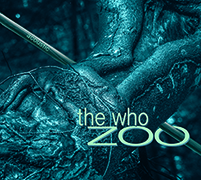 |
2. Raccitus (exc) 3. Whylateakki (complete) |
|
 |
2. Lamp Bowl (exc) 3. Kettle Opener (exc) |
|
released on Auricle Records (October 2014)
Jazz'n'More (February 2015)
Since its inception in the 90s, the Who trio has achieved a high level of spontaneous collective invention as the new double album with various shots of 2011-2013 is impressive. Since the Geneva- Wintsch and the Berne - Oester, two romantics who do not deny their lyrical flair, even if it comes in free sound explorations. And Gerry Hemingway has long recognized as a versatile, always curious musician who is committed to fully and stimulating blends. Among the precursors of this style of play include Paul Bley and Keith Jarrett a little. Usually a small idea, and all sorts of hints of pianists and alert in interaction, grow slowly and pass ideas and voltage curves, usually modal and lyrical, but also almost never without a groove. As the melodic sonic events, the rhythm through all the phases, from very subliminally to very explicitly. The first acoustic CD presents brief sketches - mostly suite-like the stream of consciousness following or abruptly separated. What stands out is the simplicity of the ideas, their development and the patient hardly ever abandoned transparency. The noise-like is closely linked to the melodious, sometimes overturned in free jazz. - On the second CD produced three long improvisations, strongly influenced by Wintsch’s excellent integrated synthesizer electronics and acoustic sounds. Also 25 minutes away assets the three to keep the voltage and the relationship fully, and in a kidnap fascinating soundscapes. Jürg Solothurnmann - Jazz'n'More (February 2015 Review of WHO Zoo on Auricle Records)
AllAboutJazz October 26, 2014
American drummer/percussionist Gerry Hemingway has made his home in Switzerland since 2009. Besides his teaching and solo performances, currently, his most accomplished working band is The WHO Trio. 'WHO' stands for Wintsch/Hemingway/Oester. It's Hemingway's unconventional piano trio with Swiss partners pianist Michel Wintsch and bassist Banz Oester.
The WHO Zoo is their fifth release, beginning with Choucas (Leo, 1999) through Less Is More (Clean Feed, 2010). Each disc has been a revelation and affirmation of this trio's like-mindedness.
These two discs are distinguished by one being an all acoustic, the other electric.
Both versions are bright and masterfully recorded. Hemingway's cymbals jump from the speakers, piano notes are crisp, and the bass lines anchor weight. That is, when Oester is wearing the cape of the timekeeper. Often he is creating melody or itching and scratching out new sounds. This trio is inclined to reinvention. Concocting new song forms and pioneering new ways to make sounds. Hemingway is a virtuoso at percussive invention, his "sounds" often inspire Wintsch to treat the piano as another percussive device, working the hammers as toms and keeping time with repetitive notes. That said, these improvisations are never doodling noise. The trio has a way of keeping their flights grounded in song. Melodies appear and are reworked, rhythmic changes have a purpose. Their instantly composed improvisations are indeed songs.
The acoustic/electric demarcation is not so much about opposition, as it is additions. Wintsch's piano is augmented by synthesizers, Hemingway adds a harmonica, and Bänz a lamp. Yes, a lamp. The difference here is that the electric pieces are all lengthy improvisations with noisier pieces of reanimation here. Does the electric disc signal a new direction for The WHO Trio, or maybe just another set of tools to mark their path? Mark Corroto AllAboutJazz October 26, 2014
The New York City Jazz Record December 2014
In existence since 1998, unlike previous efforts, Zoo, the WHO Trio’s fifth release, consists entirely of improvised pieces, spread across two CDs, which contrast acoustic and electric approaches. In truth, the differences are confined to pianist Michel Wintsch’s use of a synthesizer in conjunction with piano, as the same commitment to spontaneous composition and tonal exploration permeates both sets. The trio proves quite capable of creating extraordinary timbres without resorting to electricity, although Wintsch’s electronics considerably increase the palette of tonal color available. In a role reversal, Wintsch and bassist Bänz Oester often maintain momentum as much as Hemingway, who contrarily revels in a boisterous clatter. When Hemingway does contribute a pulse, it remains loosely defined, though lacking nothing in propulsive zeal. Hemingway makes full use of the resources at his disposal, even using his voice on the lengthy “Lamp Bowl” to add a childlike murmuring. At the piano, Wintsch proves imaginative, partial to preparations to modulate hammers on strings. He has a predilection for rhythmic patterns whatever the instrument; indeed on “Chilabreela” he seems as if he is playing variations on a Bach theme in his left hand while spinning an edgy single-note alarm with his right. Oester excels at both pithy commentary and more aggressive sound generation. “Sloeperr” stands as a highlight formed from the purposeful but unpredictable intertwining of three forceful individual strands, which sums up the trio’s appeal. John Sharpe The New York City Jazz Record October 2014
Debra Richards - Swiss Vibes - October 2014
From the opening, assured double bass note and urgent cymbal tapping to piano notes peeking shyly out, the quality of The Who Zoo is apparent. The acoustic side of this limited release, double album uphold the trio’s aim: to respectfully work on the art of improvisation.
It sounds like a whale singing of unrequited love
The track Rembellarun stands out for feeling like an actual composition, all be it a dreamlike one with Michel Wintsch at his melancholic best and Gerry Hemingway providing an edge by literally scraping the side of a cymbal. It sounds like a whale singing of unrequited love. Just when the percussive ideas begin to dominate, in rides a piano rebuff – a few notes delivered with confidence and defiance. Hemingway is a constant imaginative presence sensitively patting out ideas and allowing cymbals to whisper sweet nothings around the hook line in Demmpa. Bänz Oester tunes in, but asserts his own ideas with an intimate knowledge of strokes, caresses and pulls of his bass strings. The inventiveness of his playing borders on the magical.
I like it when they get raw and primal
I didn’t like Sloeperr to begin with, then at nine minutes in, on maybe the third listen, I got goosebumps and almost tears in my eyes as the warped hymn lines and piano poundings, bass vibrations and beatings and rattling drum funk entangled me in an emotional net. I like it when they get raw and primal. They can handle it without resorting to cliché. There are times when I’m certain Hemingway could get in chops and licks but he keeps it organic, all three staying riveted to the present moment. This favouring of the integrated ‘group solo’ enables an uninterrupted onslaught. Hemingway was a name in the ‘loft scene’ of 1970s New York where free jazz had laid the foundation and was developed by new creatives such as Joe McPhee, Don Pullen and David Murray. His presence is powerful but his depth of experience is matched by Oester and Wintsch. Michel embroiders the music with runs that sound like glass beads scattering and exquisite melodies that seem to trickle from a Peter Greenaway film soundtrack.
Debra Richards - Swiss Vibes - October 2014
 |
2. Stardance (exc) 3. Hasna (exc) |
|
WHO stands for Wintsch (Michel, piano), Hemingway (Gerry, drums and percussion) and Oester (Bänz, bass). Active for over ten years under this embodiment, these artists are as distant from an ordinarily stale jazz trio as an exhausted reviewer could wish for. For starters, we find no surplus of swing in Less Is More, which makes me extremely intrigued. There’s much else to explore, though, and the musicians are not shy in attempting different routes, all leading to a single result: the expression of simple rhythmic and melodic concepts through a superior level of restrained interplay.
Either walking across intense abstraction (the impressive opening track “Inside The Glade” is, purely and simply, a masterpiece of concerned waiting and unsettled thoughts) or examining the details of metrical interlocking almost to the point of ritualism (“The Pump”, “The Eastern Corner”), WHO always manage to look unique even by maintaining the instrumental gradations virtually untouched. “Wedding Suite” may appear as a straightforward song yet it is full of dissonance – of the digestible kind - especially remarked by the ever-interesting, outside-the-canon figurations played by Wintsch, whose style is reserved and intelligently comprehensible at once, altered melodies and harmonic cleverness bathed in inspired suggestion. Banz sounds prosperous or emaciated depending on the context, the focus remaining on the sensible aspects of structural stability. Hemingway offers a great proof of sensitive drumming throughout, the subtlety of his percussive interventions during the most rarefied sections a lesson of self-discipline that many bangers should learn.
Don’t be fooled into thinking about ECM or similar comparisons: despite a graceful confidence and the total mastery of the tools at their disposal, these men’s music is a refined blend of sensitiveness and, at times, visionary drive that does not need the support of a church’s reverberation to affirm its durability in the listener’s memory.
MASSIMO RICCI posted 22:08 THURSDAY, 22 OCTOBER 2009 Touching Extremes
Its beginning with almost the twenty minutes of “Inside The Glade” (composed by the trio) and “Still Alone” (written by pianist Michel Wintsch) shows two subjects of chilling beauty, able to absorb the listener and to transfer us to a state of eternal contemplation.
The three final pieces (“Stardance”, “Hasna” and “The Eastern Corner”, that show moments of the three musicians using their instruments in a little orthodox way, are three magnificent samples of how this trio works as a group, with subjects that are constructed little by little and that are based on deep listening between the three musicians
Tomajazz review by Pachi Tapiz (2009)
The piano trio is probably one of the most common ensembles to be heard in jazz, and truth be told, I am a little weary of them, preferring the expressiveness of a horn section. Yet once in a while, a piano trio comes forward that has something new to tell. When I listened to WHO Trio's "The Current Underneath" (Leo Records) a couple of years ago, I was immediately enchanted by the sheer musicality of the project. This one, "Less Is More", is even better. The trio consists of Michel Wintsch on piano, Gerry Hemingway on drums and Bänz Oester on bass. I have rarely come across a band who can create the perfect marriage of tension and lyricism, like this trio does. The "less is more" concept really describes the music well, there is lots of open space, but there is also tension in every note being played. Every sound is full of restraint, as if it only hints at the vast hidden world that made it possible, yet that remains unseen. Implicit music. The note that isn't played is as important as the one that is. Real beauty is revealed by suggesting it. Despite this sparsity of notes, the music itself makes sense. There is a simple beauty in it, with evolving melodic concepts, interesting compositional structures, and some extended techniques. Each piece is different, though, but all tracks fall within the same logic and supertight control. If the Japanese saying is true that beauty is "controlled passion", then this album is for sure a great example of it. 2/22/09 Stef - Free Jazz Blog
“Less Is More” (Clean Feed *****), do WHO Trio, demonstra cabalmente o que o título proclama. O pianista Michael Wintsch, o baterista Gerry Hemingway e o contrabaixista Bänz Oester (cujos apelidos formam o WHO) averiguam quais as quantidades mínimas de melodia e pulsação rítmica necessárias para manter um tema a planar. Música com a beleza e a fragilidade de gotas de orvalho numa teia de aranha, mas cuja audácia e imprevisibilidade não a deixam confundir, em momento algum, com “jazz ambiente” Time Out Lisboa review by José Carlos Fernandes.
Who Trio: cerimónia solene
Eles são [da esquerda para a direita]: Bänz Oester (baixo), Gerry Hemingway (bateria) e Michel Wintsch (piano) — suíços, o primeiro e o terceiro, americano o do meio —, e formam o Who Trio. Embora com muitas actividades repartidas pelos mais variados agrupa-mentos, o certo é que desde 1995 construíram uma intimidade musical que lhes permite lançar, agora, um prodigioso álbum que, certamente não por acaso, possui o título esclarecedor de Less Is More.
É certo que a estrutura mais clássica do trio de jazz poderia apelar a texturas mais ou menos formatadas, porventura comandadas pelo piano. Mas não: o Who Trio funciona a partir de uma democracia tonal, sempre em aberto, sempre à procura das suas próprias fronteiras, num jogo de ecos, cumplicidades e narrativas que confere a Less Is More a dimensão de uma cerimónia de minimalista solenidade. E a palavra cerimónia deverá ser entendidade nas suas significações mais radicais, incluindo a que nos remete para a contenção do sagrado - Sound + Vision review by João Lopes
The piano jazz trio is by now a familiar form—maybe too familiar. Many are already attuned to the standards-style trio (which may also cover modern pop tunes), and the free jazz trio (which is neither tethered to melody nor anchored in jazz sensibilities. But expectations need to be set aside when WHO Trio plays. The descriptive title, Less Is More, might just bear the subtitle "any more of this might just be too much."
This trio, featuring drummer Gerry Hemingway, Swiss pianist Michel Wintsch and bassist Bänz Oester, has been making music for more than 10 years now. Although each player has multiple side projects, their work together is both remarkable and quite exceptional. This is the trio's fifth recording, following The Current Underneath (Leo Records, 2004).
The intelligence of this music is in its simplicity and interplay. Only a close working group like WHO Trio could make this coherent a statement and not get in each other's way. The music, pleasing in its simplicity, samples jazz swing but eschews its boundaries. Each player, adept at free jazz, strives to maintain the focus of each thoroughly composed track. No diddling is heard here—whether Wintsch is plucking strings inside his piano, Oester is knocking wood on his bass, or Hemingway is creating a myriad of sounds on his kit, they are contributing to the whole composition.
The closest relation to this trio might be Keith Jarrett's Standards Trio, coupled with the teamwork of the Clusone Trio, and the telepathy of a classic Bill Evans recording. But unlike those bands, WHO Trio doesn't begin its exploration with covers of familiar tunes. It creates its own world, which can be beautiful and moving in ballads that combine the tension and release of jazz with the folk sensibility of a simple melody.
For all practical purposes this is a perfect recording. Mark Corroto (AAJ).
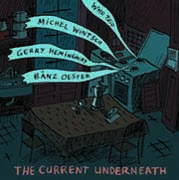 |
2. Seduna In Wallis Part 1 (exc) 3. Rabins Cat (exc) |
|
WHO- Michel Wintsch/Bänz Oester/Gerry Hemingway-The Current Underneath
Leo Records LR 391
The third release "The Current Underneath" by the trio features all-star trombonist Ray Anderson, performing on the final cut titled, “Jlrai.” Ultimately, the group uses space as an added instrument. But don’t let that fool you. The musicians do inject an abundance of pumping grooves, fiercely enacted swing motifs and finger-snapping rhythms into the grand scheme of things. Drummer Gerry Hemingway and bassist Banz Oester generate matters into overdrive on occasion, while pianist Michel Wintsch once again surfaces as an articulate improviser. The pianist often counterbalances a sequence of micro-themes with his left hand voicings amid swirling countercurrents and odd-metered pulses. They explore a myriad of disparate angles. Hence, the live element creates an uncanny sense of the visual, whereas the trio remains focused, yet loose. The music is characterized by a continuous and asymmetrically designed flow, while Wintsch creates a few well-placed gaps here and there. At times, fascinating and highly entertaining, the trio simply distinguishes itself in rather pronounced fashion throughout this absorbing affair. (Vigorously recommended…) Glenn Astarita Jazzreview.com
and from All Music Guide ...
This sophmore effort by the Who Trio -- pianist Michel Wintsch with drummer Gerry Hemingway and bassist Bänz Oester -- is a rambling, startling exercise in textures, layered dynamics, and process. Certainly it is a jazz record, rife with beautifully studied compositions and carefully articulated improvisations; as such, it is a nocturnal, silky, wonderfully wrought piece of understated mastery. The opener, "Quartier Lointain," a collective improvisation, offers a bird's-eye view of the intimacy of these proceedings. Wintsch's pianism shimmers around two different melodic ideas as Hemingway double-times his way into near silence, underlining only the briefest of phrases. Oester falls in on separate measures, collating his way through the harmonics. Eventually, the tension increases just enough to bring the band together in a taut percussive exchange before Wintsch brings back his skeletal melody to break it. It's stunning. On Wintsch's "Swantra," bopped-up piano blues and swing are offered up as ghost figures for a new kind of knotty interchange as both Oester and Hemingway syncopate the already syncopated and turn harmonics around on one another in the process. The reading of "Jerusalem" here is one of the most elegant, emotionally beautiful, and challenging ever recorded. Its deep lyricism reflects the traditionally based folk melody the tune is composed on as a jazz construct, and offers the sheerest shade of the blues as an anchor to its exoticism. And so it goes -- until the last track as Ray Anderson's trombone is added to the mix. Oester's bowed bass and Hemingway's whispering cymbals introduce the tune. "J'Irai" seems to come from the desert itself. Its slowly unfolding melody and mode reflect the spirits of ancient musics and film noir jazz before becoming a tough, slightly out post-bop swing fest. It is arresting, deep, mysterious, and profound in its subtlety. This is a provocative way to end a recording where so much has already been introduced, but when it's the Who Trio, anything and everything is possible. Awesome. ~ Thom Jurek, All Music Guide
From All About Jazz
by Ty Cumbie
View review here
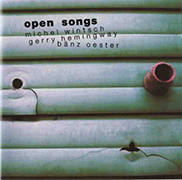 |
2. La Foule (exc) 3. Et Maintenant (exc) |
|
"Open Songs" features a number of the trio's interpretations of French chanssons.
Géraldine Martin-Jazzbreak.com
The trio Wintsch / Hemingway / Oester proposes us a very creative music with its new album
Original compositions are along side interpretations of songs from, among others, Gilbert Bécaud and Jacques Brel. With a lot of subtlety, these songs (these "Open Songs") actually open and become the crucible of a captivating re-invention.
The surprising interpretation of the "Plat Pays" really gives us the feeling to go across this scenery described by Brel. The sounds restitute the wide area and the magic becomes possible.
Open Songs resounds an astonishing beauty, sometimes on the verge of silence. We perceive behind these notes a voice, both strange and familiar, and a contained emotion which tears us one moment and exhilarates us the next.
Géraldine Martin ::june 24 2002 Jazzbreak.com
Open Songs-Altrisuoni 108 Jason Bivins, Cadence
Michel Wintsch is one of the many players on the European scene who enjoys far less exposure than the rightly should. A talented pianist who straddles genres - from chamber music to free improvisation to slinky grooves or films music - in less a channel-surfing than a synthetic fashion, he's developed his own voice with this trio for several years now. His recordings are often marked more by their sense of narrative developement than their technical bravado (he's got technique, don't worry ; he just knows when and when not to use it for the sake of the music). It helps to have such a sympathetic partners in these endavors. Oester's bass playing shares many of the virtues of Hemingway's drumming : each is able to play with equal ease in idiomatic and non-idiomatic situations, providing either a highly creative texture or a very specific pulse track.
From the opening themes on this recording, it is evident that the group is exploring repetition and minimalism more than on some earlier recordings. The dedication to Tarkovski is, if anyone needed a pointer, a fair indication of Wintsch's sensibilities as improviser : he tends toward the dramatic, if not always the cinematic. The trio brings a great deal of inventiveness to the relatively simple structure of « Offret » (Oester's pizzicato meshes particularly well with Wintsch's darting play). Looking at the basic elements of the tune from different angles seems to be the order of the day. The drama is not only internal to each composition/improvisation, but is also used to structure the album as a whole. « Le plat pays » is a somber, droning piece where Wintsch's ruminations are offset against whisking percussion and delicate arco. This, along with « Ne me quittes pas » is a Jacques Brel tune - an interesting reference to set alongside Wintsch's oftnoted classical proclivities. He sounds as if he's having a ball playing someone else's tunes, as he also does on Angel Cabral's « La foule » with is very elaborate counterlines. But to me, the finest piece here, filled with thorny statements, rhythmic knots, and open gestures as well - and the hour « Et maintenant ». This last piece returns to the quasi-minimalist feel, but with a slightly more anthemic quality. As the piece progresses, Hemingway and Oester start to swing and groovr like mad, pushing Wintsch to some of his most expressive playing. While not every piece suceeds (« Isablue » for example, has a nice ambience but doesn't really go anywhere, while « 2 pm » feels like little more than a punctuation mark), this fine piano trio is to be commended for going beyond the usual parameters.
Jason Bivins, Cadence October 2002 Vol. 28 No 10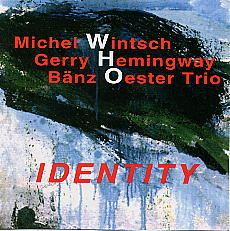 |
2. NT [Gerry Hemingway] (exc) 3. Driving Home [Bänz Oester] (exc) |
|
"Identity" on Leo Records was the trio's debut CD
Identity is yet another fine piano trio recording brought to us by "Leo Records" featuring the expertise of pianist Michel Wintsch, bassist Ban Oester and all-world drummer-composer Gerry Hemingway. Here each musician contributes compositions that run the gamut from being tightly integrated or classically tinged such as Wintsch' "Choucas" and "Anne-Marie S" along with spotty doses of congenial swing motifs and gleaming tonal contrasts all performed via a well-mannered and orderly approach. On Hemingway's composition "NT", Wintsch displays a massive yet eloquently stated percussive attack behind the keys along with a lightning quick right hand. The Trio also explore various themes via sharp, brilliantly executed improvisation on pieces such as "Link" where Hemingway's sweeping brush-work sets an unusual pattern followed by Wintsch' circular passages. "Driving Home" is a moderate swing in the classic piano trio mold as Wintsch' employs soulful passages that may fit somewhere in between Junior Mance and Monk as Oester and Hemingway stretch out with poignant well-executed solos.
Identity is persuasive, distinctive and at times striking as these musicians fuse their individual talents from a compositional and technical perspective which adds a nice touch of diversity along with a few surprises here and there. Throughout, the band state their collective identities in outward and for the most part, glistening fashion while providing the listener with captivating themes along with zealous soloing and a compelling sense of unity. A first class effort and thoroughly modernistic approach to the beloved piano trio format! Recommended...........* * * * Glenn Astarita

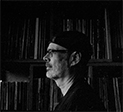 |
Pianist and composer Michel Wintsch's unflagging inspiration springs from a rich and varied musical background. Linking jazz tradition with the raw power of "progressive" rock, freewheeling improvisation with the rigors of orchestral composition, virtuoso playing with digital editing and mixing techniques, he takes an approach that is both syncretic and poetic. A way of composing that leaves plenty of creative space to fellow musicians, yet establishes a style that is his alone. He has been touring regularly with the WHO trio, among others, for the past 10 years on a worldwide scale. He has published many records and played with many musicians (Fred Frith, Han Bennink, Michel Doneda etc). He has worked as a composer for cinema (Alain Tanner), theatre and ballet as well as many other musical projects. |
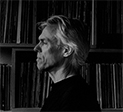 |
Gerry Hemingway has performed as a solo artist since 1974. He also has led a number of quartet & quintets since the mid 80’s as well as being a member of a wide array of collaborative groups including BassDrumBone (now existing for 43 years), Brew w/Reggie Workman & Miya Masaoka, a trio of over 30 years with Georg Graewe & Ernst Reijseger, the Swiss based WHO trio (also existing now for over 20 years) with Michel Wintsch and Baenz Oester, Tree Ear with Sebastian Strinning and Manuel Troller, as well as numerous duo projects with Marilyn Crispell, Samuel Blaser, Thomas Lehn, John Butcher, Ellery Eskelin, Jin-Hi Kim, a o. Mr. Hemingway is a Guggenheim fellow and has received numerous commissions for chamber and orchestral works. He is well known for his eleven years in the Anthony Braxton Quartet (1983-94) along with his collaborations with some of the world’s most outstanding improvisers and composers including Evan Parker, Cecil Taylor, Mark Dresser, Anthony Davis, Derek Bailey, Leo Smith, Frank Gratkowski, Simon Nabatov and many others. He continues to live in Switzerland having joined the faculty of the Hochschule Luzern in 2009. |
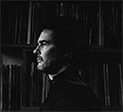 |
Bänz Oester has worked with the likes of many great jazz musicians, such as Dewey Redman, Joe Lovano, Michael Brecker, Ray Anderson, Ellery Eskelin and Chris Potter. His bass foundations and musicality has formed the backbone of multiple collaborations. Over the past 30 years he has been one of the most sought-after bassists. Currently he is performing with his quartet, The Rainmakers, in the WHO Trio with Michel Wintsch and Gerry Hemingway, in the Donat Fisch Quartett, in the trio with Hans Feigenwinter and Norbert Pfammatter and in one more trio with Alvin Schwaar and Noé Franklé. Bänz Oester is also recognized as an exceptional soloist. He knows his instrument down to the pores and continuosly explores it anew with plucking, stroking and percussive playing techniques. In his hands the bass becomes a body of sound that exceeds stylistic boundaries. He creates an architecture of music that is pure melody, emotion and groove, swinging, dancing and relishing/revelling into the warm sound that is the trademark of Bänz Oester. |

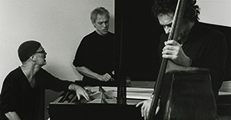
WHO Press (Strell) 9
Michel Wintsch-Baenz Oester-Gerry Hemingway - WHO Trio
Hi Rez_600 dpi - Medium Web Rez - Small Web Rez photo credit-Jordan Hemingway
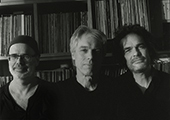
WHO Press (Strell) 7
Michel Wintsch-Baenz Oester-Gerry Hemingway - WHO Trio
Hi Rez_600 dpi - Medium Web Rez - Small Web Rez photo credit-Jordan Hemingway
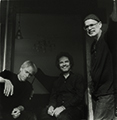
WHO Press (Strell) 6
Michel Wintsch-Baenz Oester-Gerry Hemingway - WHO Trio
Hi Rez_600 dpi - Medium Web Rez - Small Web Rez photo credit-Jordan Hemingway
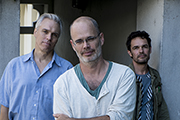
WHO trio Press Photo Fribourg1
Michel Wintsch-Baenz Oester-Gerry Hemingway - WHO Trio
Hi Rez_300 dpi - Medium Web Rez - Small Web Rez photo credit-Jordan Hemingway
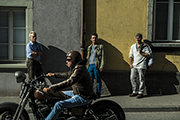
WHO trio Press Photo Fribourg2
Michel Wintsch-Baenz Oester-Gerry Hemingway - WHO Trio
Hi Rez_300 dpi - Medium Web Rez - Small Web Rez photo credit-Jordan Hemingway
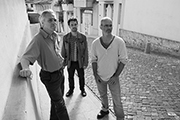
WHO trio Press Photo Fribourg3
Michel Wintsch-Baenz Oester-Gerry Hemingway - WHO Trio
Hi Rez_300 dpi - Medium Web Rez - Small Web Rez photo credit-Jordan Hemingway
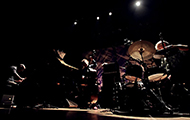
WHO Concert Photo 1 - Lausanne
Michel Wintsch-Baenz Oester-Gerry Hemingway - WHO Trio
Hi Rez_300 dpi - Medium Web Rez - Small Web Rez photo credit-Juan Carlos Hernandez
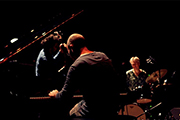
WHO Concert Photo 2 - Lausanne
Michel Wintsch-Baenz Oester-Gerry Hemingway - WHO Trio
Hi Rez_300 dpi - Medium Web Rez - Small Web Rez photo credit-Juan Carlos Hernandez
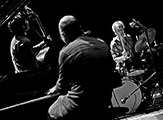
Press Photo 1 WHO Concert Photo 2 B & W- Lausanne
Michel Wintsch-Baenz Oester-Gerry Hemingway - WHO Trio
Hi Rez_300 dpi - Medium Web Rez photo credit-Juan Carlos Hernandez
WHO Trio (2-11-08) 300dpi Web Resolution[Clearclicker]